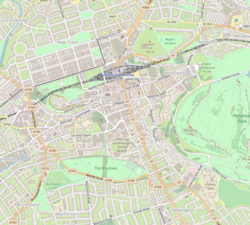St Patrick's Church, Edinburgh
| St Patrick's Church | |
|---|---|
 | |
| 55°56′59″N 3°11′05″W / 55.9498°N 3.1846°W | |
| Location | Old Town, Edinburgh |
| Country | United Kingdom |
| Denomination | Roman Catholic |
| Website | StPatricksParish.co.uk |
| History | |
| Status | Parish church |
| Dedication | Saint Patrick |
| Events | Facade added in 1929 |
| Architecture | |
| Functional status | Active |
| Heritage designation | Category B listed |
| Designated | 14 December 1970[1] |
| Architect(s) | John Baxter |
| Style | Neoclassical |
| Groundbreaking | 1772 |
| Completed | 1774 |
| Construction cost | £4,000 |
| Administration | |
| Province | St Andrews and Edinburgh |
| Archdiocese | St Andrews and Edinburgh |
| Deanery | St Giles[2] |
St Patrick's Church is a Roman Catholic Parish church in the Cowgate part of Old Town, Edinburgh, Scotland. It was built from 1771 to 1774, and became Catholic in 1856. The facade of the church was designed by Reginald Fairlie in 1929. It is situated between South Gray's Close and St Mary's Street north of Cowgate and south of the Royal Mile. It is a category B listed building.[3]
History

Construction
From June 1772 to 1774 the original church was built. It was originally a place of worship for the Scottish Episcopal Church. It was designed by John Baxter. In 1818, the church building became part of the United Presbyterian Church. The Scottish Episcopal Church commissioned Alexander Runciman to produce a series of murals for the church. These were installed but covered over by the Presbyterian congregation. Since then, some of the murals have been recovered and remain on the east side of the apse and depict the Parable of the Prodigal Son, Elijah and the Ascension of Jesus.[1]
In 1856, the church was bought by the Apostolic Vicar of the Eastern District, Bishop James Gillis. The church cost £4,000. Half of this was paid by the local congregation and the other half by the Catholic Church. On 3 August 1856, the church was opened in a Mass presided over by Bishop Gillis.[4]
Extensions
In 1898, the sanctuary for the church was remodelled and a new high altar was installed. It was designed by J. Graham Fairley. In 1921, the mortuary chapel was built in remembrance for the parishioners who died in World War One. From 1924 to 1925, two chapels were built in the church, the Lady Chapel and the Sacred Heart Chapel. In 1929, the front church facade was built. It was designed by Reginald Fairlie and included statues of St Patrick and St Brigid.[1]
Notable Persons
- Canon Edward Joseph Hannan (1836-1891) ran the church for most of his life and founded Hibernian Football Club during this period
Parish
On 6 August 1875, Hibernian F.C. was founded in St Patrick's Church. The parish priest Fr Edward Joseph Hannan and Michael Whelahan from the parish's Catholic Young Men Society decided to create the football club. On 17 March 2013 (St Patrick's Day), a plaque commemorating this founding of the club was presented to the church by the Hibernian Supporters Club.[5]
The church has four Sunday Masses; they are at 5pm on Saturday and 9:00am, 11:00am and 4:30pm on Sunday.[2]
See also
 Media related to St Patrick's Church, Edinburgh at Wikimedia Commons
Media related to St Patrick's Church, Edinburgh at Wikimedia Commons- Margaret Sinclair (nun)
- Roman Catholic Archdiocese of St Andrews and Edinburgh
References
- ^ a b c 5 South Gray's Close, St Patrick's Roman Catholic Church, Edinburgh from British Listed Buildings, retrieved 30 June 2016
- ^ a b Parishes from Archdiocese of St Andrews and Edinburgh, retrieved 30 June 2016
- ^ Edinburgh, Cowgate, St Patrick's Roman Catholic Church from Canmore, retrieved 30 June 2016
- ^ The Church from StPatricksParish.co.uk, retrieved 30 June 2016
- ^ Hibs’ Fans Present Plaque to St Patrick’s Parish Church from The Edinburgh Reporter, 18 March 2013, retrieved 30 June 2016
External links
- Churches in Edinburgh
- Listed Roman Catholic churches in Scotland
- Category B listed buildings in Edinburgh
- Roman Catholic churches in Scotland
- Roman Catholic churches completed in 1774
- 1856 establishments in Scotland
- Neoclassical architecture in Scotland
- 18th-century Roman Catholic church buildings in the United Kingdom

